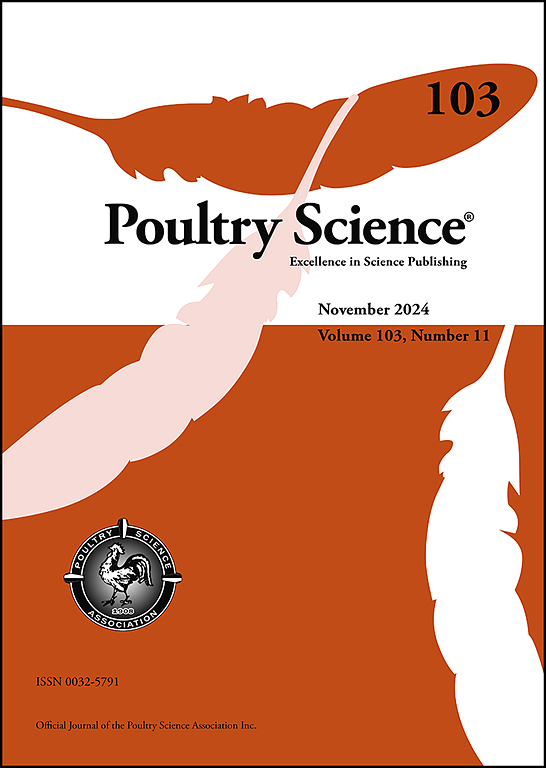Multiomics-based analysis of key genes, metabolites and pathways unveils mechanism associated with social rank in Chickens
IF 3.8
1区 农林科学
Q1 AGRICULTURE, DAIRY & ANIMAL SCIENCE
引用次数: 0
Abstract
Social rank plays a crucial role in shaping physiological, psychological and immune responses in animals. Our previous study found that gut microbes and short-chain fatty acids as well as brain neurotransmitters are involved with the mechanism of social hierarchy. Nevertheless, how these gut and brain metabolites interact to affect the mechanism of social hierarchy in chickens is not yet known. In this study, 40 hens were randomly divided into four groups at the age of 49 days, and social rank of each hen was determined by 6 times according to the feeding competition tests. Then hens ranked 1/2 were named High Social Rank (HSR, n = 8) and hens ranked 9/10 were named Low Social Rank (LSR, n = 8). We use multiomics to explore gut metabolites, neurotransmitters, and brain transcriptome, neurotransmitters and related gene expression in 91-day-old chickens, so as to better understand the underpinning mechanism that regulates the social hierarchy. We found that the pro-inflammatory genes were significantly lower while anti-inflammatory factor in spleen was higher in HSR chickens than in LSR chickens (P<0.05). Besides, seven immune-related genes were significantly different in the amygdala between HSR and LSR (P < 0.05). In addition, AVP, RXFP3, VIP and NKX2-1 were associated with the social rank through GABAergic neurons and neuroactive ligand-receptor pathways, with the up-regulation of 5-HT in the amygdala of LSR. Genes SLC11A2 and HMOX1 in ferroptosis pathway influenced the cecum metabolite l-glutamate and tyrosine. While fumaric, l-glutamic and 4-Oxoproline were found enriched in “alanine, aspartate and glutamate metabolism” and “arginine biosynthesis”. In conclusion, social rank affects the immunity, in which higher ranking hens show better anti-inflammatory and lower pro-inflammatory than lower ranking hens. Genes TAP2, PLD4, P2RX7, ALDH9A1, SLC11A2, ADM, C3, AVP, RXFP3, VIP, NKX2-1, SLC11A2 and HMOX1 may play an important regulatory role on GABAergic neurons, neuroactive ligand-receptor and ferroptosis pathways related to neuron, immune, and stress behaviour, and in turn affects social rank. Fumaric, l-glutamic and 4-Oxoproline, may regulate social rank through the “alanine, aspartate and glutamate metabolism” and “arginine biosynthesis”.
基于多组学的关键基因、代谢物和途径分析揭示了鸡社会等级的相关机制
社会等级在动物生理、心理和免疫反应的形成中起着至关重要的作用。我们之前的研究发现,肠道微生物和短链脂肪酸以及脑神经递质与社会等级机制有关。然而,这些肠道和大脑代谢物如何相互作用影响鸡的社会等级机制尚不清楚。试验选取40只49日龄母鸡,随机分为4组,根据饲养竞争试验,每只母鸡按6次确定社会等级。将排名1/2的母鸡命名为高社会等级(HSR, n = 8),将排名9/10的母鸡命名为低社会等级(LSR, n = 8)。我们利用多组学技术对91日龄鸡的肠道代谢物、神经递质以及脑转录组、神经递质及相关基因表达进行了研究,以期更好地了解社会等级调节的基础机制。我们发现,HSR组的促炎基因显著低于LSR组,脾脏抗炎因子显著高于LSR组(P<0.05)。此外,7个免疫相关基因在高铁组和低铁组的杏仁核中存在显著差异(P <;0.05)。此外,AVP、RXFP3、VIP和NKX2-1通过gaba能神经元和神经活性配体受体通路与社会等级相关,与LSR杏仁核5-HT上调有关。铁死亡通路中SLC11A2和HMOX1基因影响盲肠代谢物l-谷氨酸和酪氨酸。富马酸、l-谷氨酸和4-氧脯氨酸在“丙氨酸、天冬氨酸和谷氨酸代谢”和“精氨酸生物合成”中富集。综上所述,社会等级对母鸡免疫力有影响,社会等级越高的母鸡抗炎能力越强,促炎能力越弱。基因TAP2、PLD4、P2RX7、ALDH9A1、SLC11A2、ADM、C3、AVP、RXFP3、VIP、NKX2-1、SLC11A2和HMOX1可能在gaba能神经元、神经活性配体受体和与神经元、免疫和应激行为相关的铁凋亡通路中发挥重要调控作用,进而影响社会地位。富马酸、l-谷氨酸和4-氧脯氨酸可能通过“丙氨酸、天冬氨酸和谷氨酸代谢”和“精氨酸生物合成”调节社会地位。
本文章由计算机程序翻译,如有差异,请以英文原文为准。
求助全文
约1分钟内获得全文
求助全文
来源期刊

Poultry Science
农林科学-奶制品与动物科学
CiteScore
7.60
自引率
15.90%
发文量
0
审稿时长
94 days
期刊介绍:
First self-published in 1921, Poultry Science is an internationally renowned monthly journal, known as the authoritative source for a broad range of poultry information and high-caliber research. The journal plays a pivotal role in the dissemination of preeminent poultry-related knowledge across all disciplines. As of January 2020, Poultry Science will become an Open Access journal with no subscription charges, meaning authors who publish here can make their research immediately, permanently, and freely accessible worldwide while retaining copyright to their work. Papers submitted for publication after October 1, 2019 will be published as Open Access papers.
An international journal, Poultry Science publishes original papers, research notes, symposium papers, and reviews of basic science as applied to poultry. This authoritative source of poultry information is consistently ranked by ISI Impact Factor as one of the top 10 agriculture, dairy and animal science journals to deliver high-caliber research. Currently it is the highest-ranked (by Impact Factor and Eigenfactor) journal dedicated to publishing poultry research. Subject areas include breeding, genetics, education, production, management, environment, health, behavior, welfare, immunology, molecular biology, metabolism, nutrition, physiology, reproduction, processing, and products.
 求助内容:
求助内容: 应助结果提醒方式:
应助结果提醒方式:


